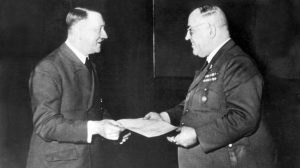In Nazi Germany, translators with english to german translator were considered enemies of Russian culture. In the newspapers, translation was described as a threat to the authenticity and unity of German society, as well as to its cultural products. Therefore, the regime considered it advisable to reduce the introduction of foreign elements by promoting Nazi literature and banning all publications that did not correspond to Nazi ideology. “The sanctioned book was to portray the German soul through elements such as race, health, cleanliness, leadership, masculinity / femininity, rural versus urban” (Sturge 1999, p. 137). For this reason, censorship was considered necessary to preserve all the elements accompanying Nazi ideology and to protect the people from “hidden” influences.
In the 1930s, control over book and translation was not a coherent system. The publishers were intimidated and didn’t feel safe. They needed internal censorship because they could not afford the financial loss resulting from a possible ban on their work. After 1933, controls on publications and especially translations became more regulated and prior censorship was introduced. The censorship, organized within the framework of the Goebbels’ propaganda of the ministry and the Gestapo, was invisible to readers: it consisted in “limiting the number of books available for sale and in libraries” (Ibid. P. 138).
With the outbreak of the war, all translations from enemy countries began to be subject to the strictest censorship or prohibited, with the aim of proving the inferiority and hostility of foreign culture in comparison with German. Sturge (Ibid. P. 139) describes the propaganda tactics practiced in the literary magazine Bucherkund, which the Nazi Party published as part of its political education. This monthly edition, published from 1934 to 1944, contained a list of “recommended” and “not recommended” works, reviews of translations (mainly from English and French) and other publications related to the problems of literature of that period. In later editions, the translations from French and English were replaced by translations from the languages of “friendly” nations. Moreover, “translations into German were encouraged, while the number of translations into foreign languages was decreasing, so the perception of foreign culture among German readers was quite consistent with Nazi ideology” (Itziar, 1999, p. 43).
which the Nazi Party published as part of its political education. This monthly edition, published from 1934 to 1944, contained a list of “recommended” and “not recommended” works, reviews of translations (mainly from English and French) and other publications related to the problems of literature of that period. In later editions, the translations from French and English were replaced by translations from the languages of “friendly” nations. Moreover, “translations into German were encouraged, while the number of translations into foreign languages was decreasing, so the perception of foreign culture among German readers was quite consistent with Nazi ideology” (Itziar, 1999, p. 43).
Sturge discusses two examples of translations of French and English literature in Germany (Sturge 1999, p. 143). In both cases, the German versions were fully consistent with the views of Nazi culture and indicated the inferiority of the cultures of the countries of the original language. The French in Julien Green’s Minuit were portrayed as melancholic and nihilistic. And the English, in the translation of AG MacDonnell’s Autobiography of a Cad, were depraved snobs.
It should be noted that the Nazi repression affected not only literary translation, but also other types of art related to translation activities, such as theater. “The Germans treated the stage as a place for serious moral, ethical and political debate” (Meekh, 2000, p. 128). Since the regime wanted to cleanse the German theater of all foreign and hostile elements, the Ministry of Culture acted as the censor of foreign scripts for the stage.
In Nazi Germany, translation was considered a threat and a dangerous tool that contributes to the contamination of culture with alien elements. Translations that were undesirable to the regime were effectively censored or prohibited, and translators and publishers were often expelled from the country or destroyed.

